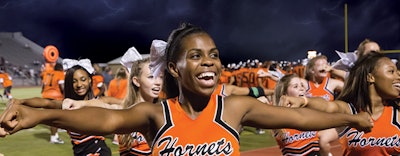
It was 1996, but Bob Dugan remembers it like it was yesterday. Soccer referee John Wade, after being alerted by a weather-detection system that a storm was on its way, removed fourth- and fifth-grade kids from the field of play. Once the storm passed, they resumed activity at Northeast Park in Park Ridge, Ill. The belief was that the storm had moved over Lake Michigan approximately 45 miles away. But instead, the storm came back, and a lightning strike killed the 20-year-old referee.
The following year, the city held a dedication ceremony in Wade's honor. Potential bad weather was expected to roll in, but well after the 6:30 p.m. ceremony. Dugan, president of Thor Guard, a lightning prediction equipment manufacturer, was driving home from the ceremony when lightning came down from the sky. "I had a sick feeling that it came down in Park Ridge," he says. "I got home and there were messages galore."
Lightning had indeed struck in Park Ridge on the exact date it had done so the previous year. But this time, the only casualty was a scoreboard and two light poles at one of the city's major parks. What no doubt saved lives that day by alerting people to take shelter was a lightning detection system Dugan had rushed to install — one that hadn't even been tested.
"Because of how the sky looked, everyone thought it was a test," remembers Dugan. "But everyone sought shelter and 12 minutes after the horn sounded, lightning struck."
The historic incident not only changed how Dugan approached business — park districts now account for the largest percentage of his client base — but demonstrated the frightening unpredictability of how weather-related incidents can impact players, fans and officials at sporting events.
A CLOUDY APPROACH
Bob Roberts, emergency manager for Tulsa (Okla.) Public Schools, points the finger at one common mistake that is consistently made by athletics administrators, particularly at the high school level, in terms of their weather preparation and management. "It's lack of awareness of what the threat is and what steps need to be taken to protect themselves," he says. "With tornadoes or high winds, they all too often rely on outdoor sirens, but by the time you hear outdoor sirens and you have 3,000 people that you're trying to get out of the stadium and into a safe place, it's too late."
Unpredictable weather conditions are commonplace in Oklahoma, something Roberts' colleague Steve Friebus, coordinator for sports medicine for Tulsa Public Schools, found out after growing up in southern California. "You knew when a rain storm was coming for three days in southern California. Here, you're lucky to get 30 minutes of lead time," Friebus says. "Pop-up storms come out of nowhere, so you have to be paying attention to weather reports, forecasts and be in touch with various monitoring systems and meteorologists. The type of weather threat and type of sporting event should determine what type of lead time you need to clear a venue."
Steve Wilkinson, warning coordinator meteorologist with the National Weather Service's Jackson, Miss., branch, has worked with the National Center for Spectator Sports Safety and Security (NCS4) to communicate the importance of accessing weather information, along with consulting an expert meteorologist, to help sports security leaders make the proper safety-related decisions.
"For professional, NCAA or even high school sporting events, the information they need is there, they just need to tap into the proper resources," Wilkinson says. And while numerous weather conditions can impact outdoor sports from the spring through fall seasons, lightning remains the top weather-related issue. Working exclusively with emergency-management personnel, meteorologists from the National Weather Service can provide up-to-the-minute weather information at no charge, but that's as far as the service goes.
"We don't make the decisions, we simply provide the information for someone else to make the decision," Wilkinson says. "We can tell someone that there's a storm coming with lots of lightning and strong winds in 30 minutes, and they may choose to not do anything with it or they may choose to shut the event down and reconvene when the threat's over."
RELATED:
Technology, Education Keys to Keeping Athletes Safe from Lightning
Lightning Prediction or Detection a Must, Experts Say
RIDE THE LIGHTNING
Determining whether or not to evacuate a venue and when to do so is perhaps the biggest challenge to those running athletic events across the country. As Friebus notes, "Some will tell me when the lightning is within three miles, then they will stop the game, while others will do it when it's 10 or 12 miles away."
Roberts was testing a Thor Guard system at a Tulsa high school when personnel were notified a storm was coming by the system despite no visible warnings. "It wasn't raining and they didn't see anything on the horizon," says Roberts. "But within 10 minutes, they had a lightning strike a few hundred feet away from where a lot of the kids would've been standing."
Modern weather safety systems can help provide peace of mind to nervous event organizers who don't want to prematurely make a decision to evacuate, but also don't want to wait too long. Last year at a professional women's golf tournament, there were storms between four and 15 miles from the event on Thursday and Friday. The lightning prediction system kept play going an additional three hours each day when it would've been called otherwise. With bad weather on Monday, the tournament would not have been completed on Tuesday. "Had a detection system not been operating there, they would've had it shut down even more than three hours those first two days just because there was so much lightning in the area," says Dugan. "But it's a nerve-wracking type of decision to make."
ACCURATE FORECAST
Advice and technological support will ultimately only go so far, and in the end, event organizers and athletics administrators must have the proper emergency action plan in place to successfully respond to each and every possible weather scenario.
"The most important thing that athletic directors must do when putting a plan together is figure out what their threats are," Roberts says. "They need to be talking to local emergency managers and the fire department, finding out what exactly are the risks."
Friebus takes it a step further, holding coaches accountable for the safety of their players and fans, as well. "Coaches need to know and have the resources to understand the threat of storms, track storms and be aware of them," he says. "Have a plan of action. If something happens, where do the kids go? What will you do? Understand that not every situation is going to be exactly the same. But if you don't have a plan of action, then it's a plan for failure."
Dennis Van Milligen is former editor in Chief for Athletic Business.
This article originally appeared in the Spring 2015 issue of Gameday Security with the title "WEATHER THE STORM"




































